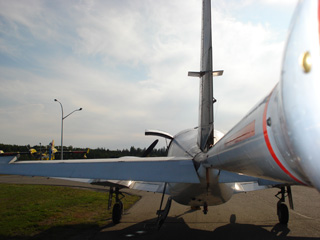
A qualified geophysical company is capable of providing a wide range of geophysical surveying services, though typically specialize in either ground or airborne acquisition. The capabilities of a geophysical company are contingent upon their years of survey experience within the field of geophysical exploration as well as their dedication to quality QA/QC and
good field practices to achieve quality data and therefore quality results.
Significantly modifications to aircraft, and specialized data acquisition systems are required to obtain consistently accurate survey data. Aircraft undergo months of modifications which ensure that the aircraft is "magnetically quiet” for survey operations. Modifications include isolating generators, removing ferrous materials and removing and regularly degaussing potentially magnetic parts.
Geophysical companies field on-site geophysicists who review the flight data on a flight by flight daily basis to ensure quality control and good calibration practices prior to forwarding each flight's data to the company office for in-house final data processing.
The information obtained during a geophysical survey is often the instigating factor in an extensive mineral exploration. As such, it is of upmost importance that the data meets industry standards. Sub par survey data is costly and may result in missed opportunities or potentially even wasted expenditures on areas which do not warrant further exploration.
Therefore, mining companies should research the capabilities and qualifications of their geophysical survey companies prior to awarding a survey.
Factors to consider when researching geophysical companies are experience, sophistication of aircraft and the quality of the data acquired by that particular geophysical system.
Unlike a regular aircraft, those used in airborne geophysical surveys will have specific modifications designed each specific type of geophysical survey.
Small aircraft such as a Terraquest's Cessna 206 use fixed-wing horizontal gradiometers for detailed surveys that are used to detect anomalies. The measured horizontal gradient data that is acquired has the following benefits:
-
Can detect precise location of dykes, faults and contacts
-
Can discriminate between small geological sources and cultural sources
-
Can identify the magnetic axis within magnetic units
-
Can identify the precise location of small anomalies between flights
In an airborne magnetic survey, a sophisticated data acquisition system will have the following characteristics:
-
Real time graphical display
-
Multiple analog inputs
-
No need for post-flight corrections (an inability to erase post-flight data can render an entire survey useless)
-
Immediate notifications of aircraft's magnetic signature
-
Magnetic dropouts can be corrected right as they occur
-
Flight path planning
These are just a few of the important aspects to consider when sourcing a geophysical company.
Geophysical surveys are beneficial tools in gathering information for geophysical mapping, as well as mineral prospecting. Quality data obtained from a magnetic geophysical survey can indicate magnetic anomalies where valuable resources and commodities are under the Earth's surface. Electromagnetic (EM) surveys are capable of acquiring data regarding nonmetallic resources and their concentrations below clay-ridden rock, groundwater and bedrock.